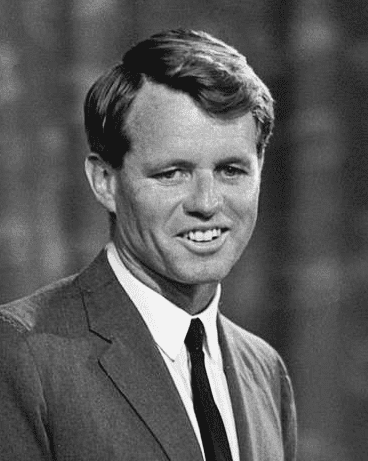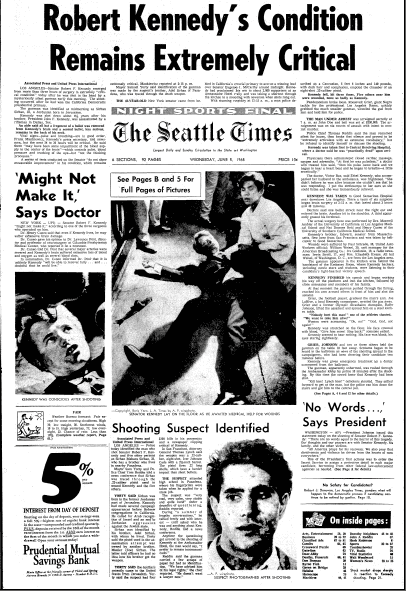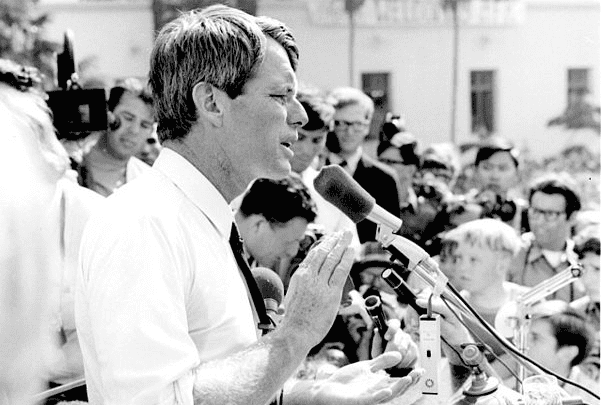Only 4½ years after his older brother, President John F. Kennedy, was assassinated – and just two months after civil rights leader Dr. Martin Luther King, Jr., had been gunned down – America awoke on 5 June 1968 to read the horrifying news that another of the nation’s young leaders had been attacked: Senator Robert F. Kennedy. He was shot three times by a Jordanian, Sirhan Sirhan, in the Ambassador Hotel in Los Angeles right after giving a victory speech in the California Democratic presidential primary. Five others were wounded in the shooting as well.

RFK had only entered the presidential primary in March, but was rapidly gaining momentum. Winning the California Democratic primary over his rival Senator Eugene J. McCarthy on June 4, Kennedy gave his victory speech to a gathering of about 2,000 buoyant supporters in the hotel’s ballroom. He ended his victory speech shortly after midnight and headed for the hotel’s kitchen, a shortcut to get to a press conference. At 12:15 a.m., 5 June 1968, Sirhan struck and Kennedy fell to the floor, bleeding and mortally wounded from the gunshots.
He clung to life for 26 difficult hours, but died early in the morning of June 6. He was 42 years old. America had lost another legendary leader, felled by an assassin. Sirhan later said he was angry over Kennedy’s support for Israel.
Here is the shocking newspaper front page editorial that readers in the Seattle, Washington, area saw that day.

The lead news story reports:
Robert Kennedy’s Condition Remains Extremely Critical
Associated Press and United Press International
Los Angeles—Senator Robert F. Kennedy emerged from more than three hours of surgery in extremely “critical condition” today after he was shot in the head by a mysteriously silent gunman early this morning. The shooting occurred after he had won the California Democratic presidential primary.
The gunman was identified at midmorning as Sirhan Sirhan, 23, a Jordanian born in Jerusalem.
Kennedy was shot down about 4½ years after his brother, President John F. Kennedy, was assassinated by a rifleman in Dallas, Tex.
An aide said all but a fragment of a bullet was removed from Kennedy’s brain and a second bullet, less serious, remains in the back of his neck.
Vital signs—pulse and breathing—are in good order, Frank Mankiewicz, Kennedy’s press secretary, told newsmen, but the next 24 to 36 hours will be critical. He said there “may have been some impairment of the blood supply to the center of the brain”—which controls pulse, blood pressure and tracking of the eye—but “not the thinking processes.”
A series of tests conducted on the senator “do not show measurable improvement” in his condition, which remains extremely critical, Mankiewicz reported at 2:15 p.m.
Mayor Samuel Yorty said identification of the gunman was made by the suspect’s brother, Adel Sirhan of Pasadena, who was traced through the death weapon.
The 42-year-old New York senator came from behind in California’s crucial primary to accrue a winning lead over Senator Eugene J. McCarthy around midnight. Kennedy had proclaimed his win to about 2,000 supporters at an Ambassador Hotel rally and was taking a shortcut through the kitchen to a meeting with newsmen when shots rang out.
With stunning rapidity at 12:15 a.m., a man police described as a Caucasian, 5 feet 6 inches and 140 pounds, with dark hair and complexion, emptied the chamber of an eight-shot .22-caliber pistol.
Kennedy fell, hit three times. Five others near him were wounded, none as badly as Kennedy.
Pandemonium broke loose. Roosevelt Grier, giant Negro tackle for the professional Los Angeles Rams, quickly grabbed the much smaller gunman, wrestled the gun from him and held him for police.
The man under arrest was arraigned secretly at 7 a.m. as John Doe and bail was set at $250,000. The arraignment was on six accounts of assault with intent to commit murder.
Police Chief Thomas Reddin said the man remained silent for hours, then broke that silence and proved to be “extremely articulate with an extensive vocabulary,” but he refused to identify himself or discuss the shooting.
Kennedy was taken first to Central Receiving Hospital, where a doctor said he was “practically dead” upon arrival.
Physicians there administered closed cardiac massage, oxygen and adrenalin. “At first he was pulseless,” a doctor who treated him said, “then his pulse came back and we began to hear a heartbeat and he began to breathe—a little erratically.”
The doctor, Victor Baz, said Ethel Kennedy, who accompanied her husband in the ambulance, was frightened. “She didn’t believe he was alive because she couldn’t see that he was responding. I put the stethoscope to her ears so she could listen and she was tremendously relieved.”
Kennedy was taken to Good Samaritan Hospital near downtown Los Angeles. There a team of six surgeons began brain surgery at 3:12 a.m. that lasted about 3 hours and 40 minutes.
Doctors said one bullet struck near the right ear and entered the brain. Another hit in the shoulder. A third apparently grazed his forehead.
The actual surgery here was performed by Drs. Maxwell Ambler of the University of California at Los Angeles Medical School and Nat Downes Reid and Henry Cuneo of the University of Southern California Medical School.
Kennedy’s brother, Edward, senator from Massachusetts, flew here from San Francisco and was taken by helicopter to Good Samaritan.
Wounds were suffered by Paul Schrade, 30, United Auto Workers official; William Weisel, 30, unit manager for the American Broadcasting Co.; Ira Goldstein, 19, a radio newsman; Irwin Stroll, 17; and Mrs. Elizabeth Evans. All but Weisel, of Washington, D.C., are from the Los Angeles area.
The gunman appeared in the kitchen area behind the bandstand of the Embassy Room, where Kennedy backers, including movie stars and students, were listening to their candidate’s light-hearted victory speech.
Kennedy finished his speech and began working his way off the platform and into the kitchen, followed by close associates and members of his family.
At that moment the gunman pushed through the throng, reached his arm around others in front of him and shot the senator.
Grier, the football player, grabbed the man’s arm. Joe LaHive, a local Kennedy campaigner, wrested the gun away. Grier and a former Olympic decathlon champion, Rafer Johnson, lifted the assailant and spread him on a steel kitchen table.
“Nobody hurt this man!” one of the athletes shouted. “We want to take him alive!”
Women were screaming, “Oh no!” “God, God, not again!”
Kennedy was stretched on the floor, his face covered with blood. “Give him room! Step back!” someone yelled.
Kennedy seemed to hear nothing. His face was blank, his eyes staring sightlessly.
Grier, Johnson and two or three others held the gunman on the table 10 feet away. Screams began to be heard in the ballroom as news of the shooting spread to the campaigners, who had been cheering their candidate two minutes before.
Kennedy was given emergency treatment by a doctor summoned from the ballroom.
The gunman, apparently unharmed, was rushed through the Ambassador lobby by police 10 minutes after the shooting. By this time the crowd knew that Kennedy had been shot.
“Kill him! Lynch him!” onlookers shouted. They milled forward to get at the man, but the police ran him down the stairs and got him to the central jail.
Learn more about Robert F. Kennedy’s life, political career and assassination in GenealogyBank’s newspaper archives: https://www.genealogybank.com/gbnk/?fname=robert+f.&lname=kennedy
Download our free family tree chart template to create your own personalized family tree chart like the Robert F. Kennedy family tree chart featured above: https://blog.genealogybank.com/family-tree-template-free-download
Related Articles:
